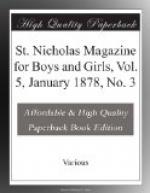And a hard time it has of it, to be sure. Nothing but pure gold and silver could ever stand such treatment. It is melted again, dissolved in nitric acid, squeezed under immense pressure, baked in a hot cellar, and finally carried to this dingy-looking room, at the left of the court-yard, where we have stood all this time. The metal is perfectly pure now, but before the final melting one-tenth of its weight in copper is added to it, to make it hard enough to bear the rough usage which it will meet with in traveling about the world.
The room would be dark but for the fiery glow of the furnaces which line one end of the place. On these are a number of small pots, filled with red-hot liquid metal; and while we look, a workman lifts one after another, with a pair of long tongs, and pours the glowing gold in streams into narrow iron molds.
“This piece of gold,” says the usher, taking up one of the yellow bars from a cold mold, “is called an ingot, and is worth about 1,200 dollars.”
One of the party asks why one end of the ingot is shaped like a wedge.
“That it may enter easily between the rollers,” is the reply. “You will see the rollers when we go upstairs.”
The guide calls our attention to the curious false floor, made of iron in a honey-comb pattern, and divided into small sections so that it can be readily taken up to save the dust. He tells us that the sweepings of these rooms have sometimes proved to be worth fifty thousand dollars in a single year. The particles which adhere to the workmen’s clothing are also carefully saved, and there is an arrangement in the chimney for arresting any light-minded atoms that may try to pass off in the smoke.
We would gladly remain longer, peering in at the glowing fires and the swarthy figures of the workmen, but our guide is already half-way across the court, and we reluctantly follow, stepping aside to make room for a workman with his burden of silver bars, which he is carrying to the next process.
This takes place in the rolling-room, where the short, thick ingots are pressed between two steel rollers, again and again, till they are rolled down into long thin ribbons of metal about the thickness of a coin.
[Illustration: THE ROLLERS.]
The next step in the work is to draw the metal ribbons through a “draw-plate,” to bring them down to an exactly uniform thickness. This pulling through a narrow slit in a steel plate hardens the metal, and again and again it has to be put in the fire and brought to a light red to make it soft and pliable. This drawing and annealing brings each band of metal to just the right thickness and condition, and we may go on and see the cutting-presses that stamp out the round pieces of metal called “planchets.” A workman takes a ribbon of gold and inserts the end in the immense jaws of the press, and they bite, bite and bite, and the round bits of gold drop in a shower into a box below.




